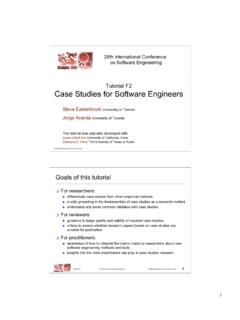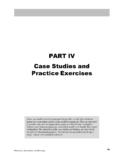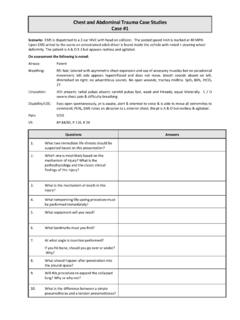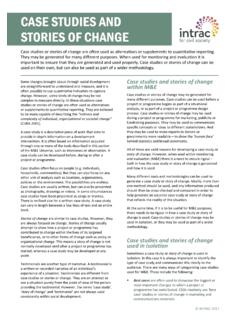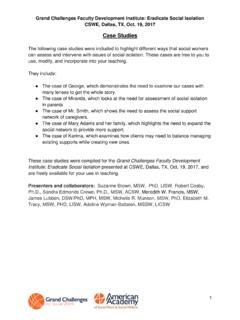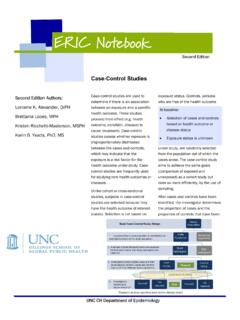Transcription of Supreme Court Case Studies - Union Township School District
1 Supreme CourtCase Studies To the TeacherThe Supreme Court case Studiesbooklet contains 68 reproducible Supreme Court case cases include landmark decisions in American government that have helped and continue to shape this nation, as well as decisions dealing with current issues in American society. Every case includes background information, the constitutional issue under consideration, the Court sdecision, and where appropriate, dissenting two-page study requires students to analyze the case and apply critical thinking answer key is provided in the back of the by The McGraw-Hill Companies, Inc. All rights reserved. Permission is granted toreproduce the material contained herein on the condition that such material be reproduced only forclassroom use; be provided to students, teachers, and families, without charge; and be used solelyin conjunction with Glencoe Social Studies products.
2 Any other reproduction, for use or sale, is prohibited without written permission from the all inquiries to:Glencoe/McGraw-Hill8787 Orion PlaceColumbus, Ohio 43240 ISBN 0-07-830788-0 Printed in the United States of America12345678910 047 0706050403 Glencoe/McGraw-HillTable of ContentsTo the Teacher .. iiSupreme Court case StudiesCase Study 1 , 1803 .. 1 case Study 2 , 1819 .. 3 case Study 3:Dartmouth , 5 case Study 4 , 1824 .. 7 case Study 5:Dred , 1857 .. 9 case Study 6:Ex Parte Milligan, 1866 .. 11 case Study 7:Slaughterhouse Cases, 1873 .. 13 case Study 8 States, 1879 .. 15 case Study 9 , 1896 .. 17 case Study 10:Northern Securities States, 19 case Study 11 States, 21 case Study 12 States, 1919 .. 23 case Study 13 York, 1925 .. 25 case Study 14 , 27 case Study 15 States, 1928.
3 29 case Study 16 , 1931 .. 31 case Study 17 , 1932 .. 33 case Study 18 , 1937 .. 35 case Study 19:West Coast , 1937 .. 37 case Study 20:Minersville School , 1940 .. 39 case Study 21 , 41 case Study 22:West Virginia State Board of , 43 case Study 23 States, 1944 .. 45 case Study 24 States, 1944 .. 47 case Study 25 of Education, 1947 .. 49 case Study 26 of Education, 51 case Study 27 States, 1951 .. 53 case Study 28 York, 55 case Study 29 of Education of Topeka, Kansas, 1954 .. 57 case Study 30:Ya t e States, 59 case Study 31 States, 61 case Study 32:Mapp , 1961 .. 63 case Study 33 , 1962 .. 65 Supreme Court case StudiesiiiCase Study 34 , 67 case Study 35:Abington School , 1963 .. 69 case Study 36 , 1963 .. 71 case Study 37 , 1964.
4 73 case Study 38 , 1964 .. 75 case Study 39 , 77 case Study 40:Heart of Atlanta States, 79 case Study 41 , 1966 .. 81 case Study 42 , 1966 .. 83 case Study 43 States, 1967 .. 85 case Study 44 , 1969 .. 87 case Study 45:New York States, 1971 .. 89 case Study 46 , 91 case Study 47 d e r, 93 case Study 48 , 1973 .. 95 case Study 49:United , 1974 .. 97 case Study 50 , 1976 .. 99 case Study 51:Regents of the University of , 101 case Study 52:Kaiser Aluminum and Chemical b e r, 103 case Study 53:New L . O ., 1985 .. 105 case Study 54 , 1985 .. 107 case Study 55:Bethel School , 1986 .. 109 case Study 56:Hazelwood School , 111 case Study 57 Labor Executives Association, 1989 .. 113 case Study 58 , Missouri Department of Health, 1990.
5 115 case Study 59 , 1991 .. 117 case Study 60:International Union , Controls, Inc., 1991 .. 119 case Study 61 , 1991 .. 121 case Study 62 , 1991 .. 123 case Study 63 , 1993 .. 125 case Study 64:National Organization for Women (NOW) , 1994 .. 127 case Study 65 , 1997 .. 129 case Study 66 rd l o w, 2000 .. 131 case Study 67 , 133 case Study 68 Trucking Associations, 2001 .. 135 Answer 137ivSupreme Court case StudiesName Date Class Supreme Court case Studies1(continued) Supreme Court case Study 1 The Supreme Court s Power of Judicial Review Marbury v. Madison, 1803 Background of the case The election of 1800 transferred power in the federal government from the Federalist Partyto the Republican Party. In the closing days of President John Adams s administration, theFederalists created many new government offices, appointing Federalists to fill them.
6 One of the last-minute or midnight appointments was that of William Marbury. Marbury wasnamed a justice of the peace for the District of Columbia. President Adams had signed thepapers, but his secretary of state, John Marshall, somehow neglected to deliver the papers necessary to finalize the new president, Thomas Jefferson, was angry at the defeated Federalists attempt to keepa dead clutch on the patronage and ordered his new secretary of state, James Madison, not todeliver Marbury s commission papers. Marbury took his case to the Supreme Court , of whichJohn Marshall was now the Chief Justice, for a writ of mandamus an order from a Court thatsome action be performed commanding Madison to deliver the commission papers in accordance with the Judiciary Act of Issue Article III of the Constitution sets up the Supreme Court as the head of the federal judicial system.
7 Historians believe that the Founders meant the Court to have the power ofjudicial review, that is, the power to review the constitutionality of acts of Congress and toinvalidate those that it determines to be unconstitutional. The Constitution, however, doesnot specifically give the Court this Justice John Marshall, as a Federalist, believed strongly that the Supreme Courtshould have the power of judicial review. When the Marburycase presented the perfectopportunity to clearly establish that power, Marshall laid out several points which the Courtbelieved supported the right of judicial review. At the time, the decision was viewed as acurtailment of the power of the president, but people today recognize that the case estab-lished, once and for all, the importance of the Supreme Court in American government.
8 The Supreme Court s Decision Justice Marshall reviewed the case on the basis of three questions: Did Marbury have a rightto the commission? If so, was he entitled to some remedy under United States law? Was thatremedy a writ from the Supreme Court ? Marshall decided the first question by holding that an appointment is effective once a commission has been signed and the seal affixed, as Marbury s commission had , Marbury had been legally appointed, and Madison s refusal to deliver the Copyright by The McGraw-Hill Companies, Date Class 2 Supreme Court case StudiesSupreme Court case Study 1 (continued)DIRECTIONS:Answer the following questions on a separate sheet of is the Marburycase important in the history of the Supreme Court ? what way did the Marburydecision enhance the system of checks and balances provided for in theConstitution?
9 Scholars have pointed out there is an inconsistency in Justice Marshall s opinion withrespect to what the Constitution specifically provides. What is that inconsistency? United States is one of the few countries in which the highest Court of the land has the power to declare a law unconstitutional. Do you believe that such a power is of benefit to a country? Explain your John Marshall was a Federalist who believed in a strong national government and certainlymoved in this direction with his Marburyruling. Do you think it is proper for a Supreme Court justiceto allow his or her personal political opinions to influence the rulings of the Court ? by The McGraw-Hill Companies, violated Marbury s right to the appointment. In response to the second question,Marshall held that Marbury was entitled to some remedy under United States final question examined whether the Court had the power to issue the writ.
10 Marshallexplained that the right to issue writs like the one Marbury was requesting had been grantedthe Court by the Judiciary Act of 1789. This law, however, was unconstitutional and voidbecause the Constitution did not grant Congress the right to make such a law. In his writtenopinion, Marshall defended the right of the Court to declare a law unconstitutional: It isemphatically the province and duty of the judicial department to say what the law is ..Iftwo laws conflict with each other, the courts must decide on the operation of each. TheSupreme Court thus became the final judge of constitutionality, thus establishing the principleof judicial the time, observers were much more interested in the practical result of the ruling that the Court could not issue the writ, and could not, therefore, force the appointment ofMarbury.
